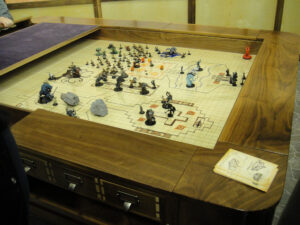Over the past few weeks, Dave has talked about six roles the GM plays—Director, Writer, Referee, Host, Actor, and Tactician—and how each of those roles helps to make a fun and memorable game.
During the Game Summary
A good GM runs a smooth game by making his players comfortable immersing themselves in the game, by running a game that his players want to play in, and by making quick, appropriate decisions relating to his game world.
Away from the Game
Another aspect of running a smooth game is to make sure everything that needs to be prepared ahead of time is already taken care of.
Handouts
If there are any handouts, such as a campaign newsletter, a newspaper of current campaign events, or summaries of the last session, the GM should have them prepared beforehand, with enough copies for everyone that needs one.
Props
If there are any props for the game, whether homemade or store-bought, they should be ready to go and easily available. Props haven’t shown up very often in the games I’ve been in, but the ones that I’ve seen have added a lot to the game. The most common props are paper-based. Ancient scrolls, death threat notes, programs and brochures, etc. are easy to put together. An ancient scroll that is printed on brittle, yellowed paper will require delicate handling if the players want to keep the information intact. A death threat or ransom note made from cutout magazine letters pasted onto paper will be studied over and over by the players as they try to find a hidden clue, or to determine which magazines the letters were cut from so they can form a psychological profile of the criminal. Programs and brochures for events, organizations, places, and merchandise can add flavor to a game, as well as adding some background
information on part of the game world.
Example: I created a tri-fold brochure for Night Archer’s hunted, The Honorable Order of Humans Only (HOHO). He used to be the leader of the group, until they left him for dead and a superhero saved his life.
Art & Photos
If the GM wants to have pictures (either drawn, cut from a magazine, or photographed) of people, places, and things to show his players, they should obviously be readied ahead of time. Having a pile of pictures for possible NPC encounters is a great way to add a face to a name. Lots of magazine cutouts, clip art printouts, or hand-drawn illustrations can be stored in a folder until needed.
Example: The heroes encounter a pawn shop manager and are trying to get some information out of him. One of the players asks what he looks like, so the GM reaches into his folder of unused pictures, and pulls out a picture of a portly, round-faced man wearing a navy blue T-shirt with lettering that has long since faded into unreadability. The sweaty man has red hair and a scruffy goatee. He seems to have part of a tattoo poking out of his shirtsleeve.
Of course, the GM could always think up an appearance and describe the man verbally, but if the heroes have to go talk to him again in a few months, will anyone remember what he looks like? Even with a resident note-taker, its likely that not all of the visual details will have been logged.
Why dont you take a picture? It’ll last longer!
(Pee-Wee Herman in Pee Wee’s Big Adventure)
After the game (or at a breakpoint somewhere during it), the GM can write the name, job, location, and other pertinent information about the man on the back of the picture (if it’s a drawing or printout), or on a piece of paper with the picture attached (if it’s a cutout).
Maps, Counters, and Figurines
If the group uses hex maps for combat, make sure a clean one is ready (unless, of course, the game is continuing from the middle of a combat last session). And have lots of figurines and counters available to pick from.
Administrivia
If any game utilities, such as combat sheets, are used, have them prepared ahead of time. One of my GMs actually has two marker-erasable whiteboards in his gaming room to track combat sheets and other info.
Away from the Game Summary
A GM who prepares for the game has more free time and energy during the game to run it well.
Next Time
A good GM is only half the equation for a good game. Part 2 will discuss good players.
Game preparation advice could fill a mountain of books (Johnn Four’s Roleplaying Tips website is proof enough of that.) Have any of your own to share?

